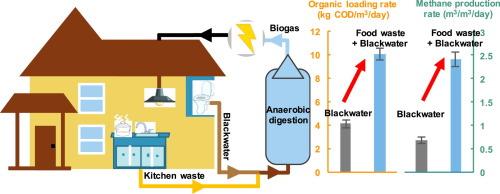Chemical Engineering Journal ( IF 13.3 ) Pub Date : 2020-04-06 , DOI: 10.1016/j.cej.2020.124911 Mengjiao Gao , Lei Zhang , Yang Liu

|
In this study, food waste (FW) was added into source-diverted blackwater (BW) to enhance biomethane production using an upflow anaerobic sludge blanket (UASB) reactor at 35 °C. Increasing amount of FW was introduced into the BW according to the BW:FW volatile solids (VS) mixing ratios ranging from 1:0.3 (BW:FW) to 1:1.5. The optimal biomethane recovery efficiency was achieved when BW:FW VS mixing ratio was 1:1, corresponding to an organic loading rate (OLR) of 10.0 (± 0.5) kg chemical oxygen demand (COD)/m3/day, which is 2.5 times of the highest OLR reported in the literature for BW treatment (4.1 kg COD/m3/day). Under this condition, a methane production rate of 2.42 (± 0.15) L/L/day (highest biomethane recovery efficiency for BW treatment studies reported to date) was achieved, which represented 96.8 MJ/m3/day heat recovery. The enhanced biomethane production was attributed to the significantly improved solid substrate hydrolysis efficiency (85.9% higher than BW only) and microbial activities (sludge hydrogenotrophic methanogenic activities 2.4 times higher than BW only). Further OLR increase with more FW addition led to a reduction in methane production due to insufficient sludge retention. It can be concluded that anaerobic co-digestion of BW and FW is an attractive approach to maximize biomethane recovery efficiency from domestic wastewater in future decentralized wastewater treatment facilities.
中文翻译:

高负荷餐厨垃圾和黑水厌氧消化:最大程度地回收生物能源
在这项研究中,将食物废物(FW)添加到源改道的黑水(BW)中,以使用35°C的上流厌氧污泥床(UASB)反应器来提高生物甲烷的产生。根据BW:FW挥发性固体(VS)的混合比(从1:0.3(BW:FW)到1:1.5),将越来越多的FW引入到BW中。当BW:FW VS混合比为1:1时,可获得最佳的生物甲烷回收效率,对应于有机负荷率(OLR)为10.0(±0.5)kg化学需氧量(COD)/ m 3 /天,即2.5文献中报道的BW治疗最高OLR的次数(4.1 kg COD / m 3/天)。在此条件下,甲烷产量达到2.42(±0.15)L / L /天(迄今为止报道的BW处理研究中最高的生物甲烷回收效率),代表96.8 MJ / m 3 /天的热回收率。生物甲烷产量的增加归因于固体底物水解效率(仅比BW高85.9%)和微生物活性(污泥的氢营养甲烷化活性比仅BW高2.4倍)显着提高。由于污泥滞留量不足,进一步增加FW并增加FW导致甲烷产量减少。可以得出结论,在未来的分散式废水处理设施中,BW和FW的厌氧共消化是一种最大化从生活废水中回收生物甲烷的有效方法。











































 京公网安备 11010802027423号
京公网安备 11010802027423号